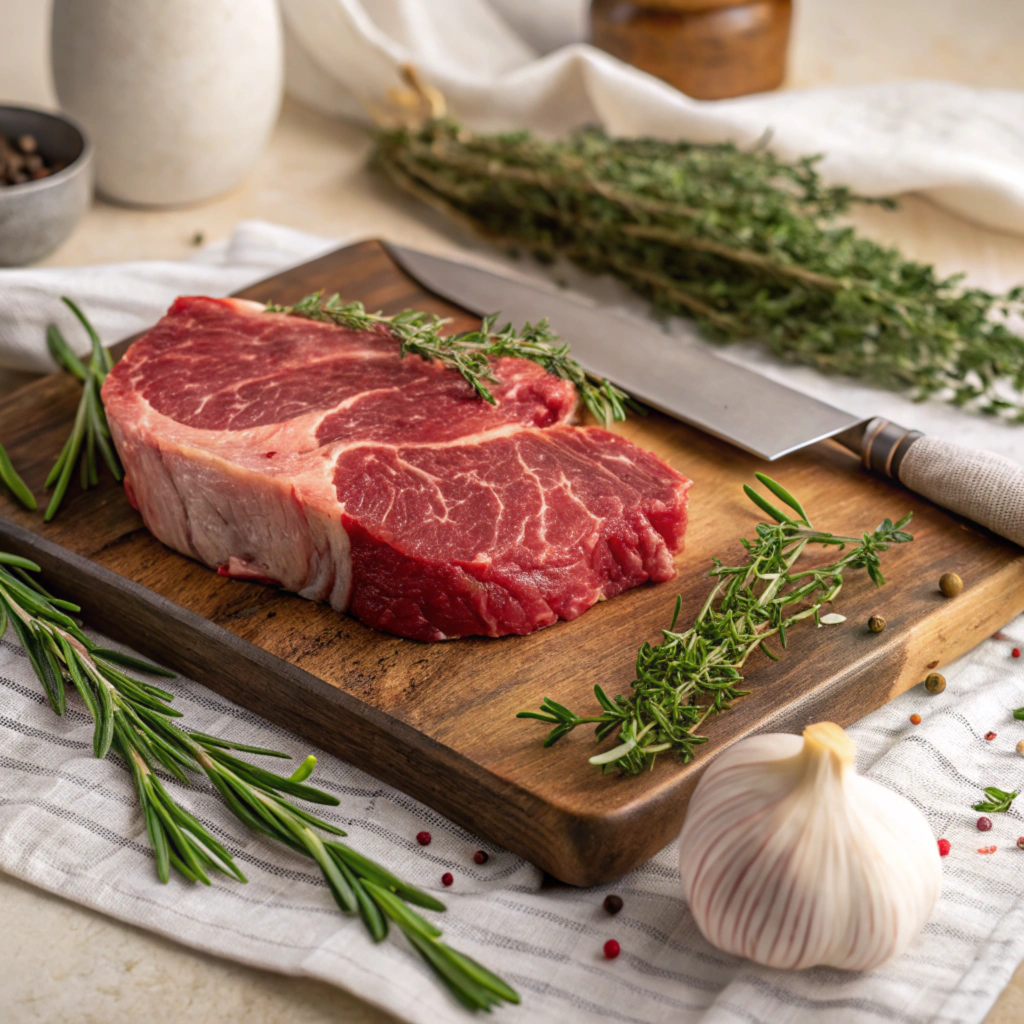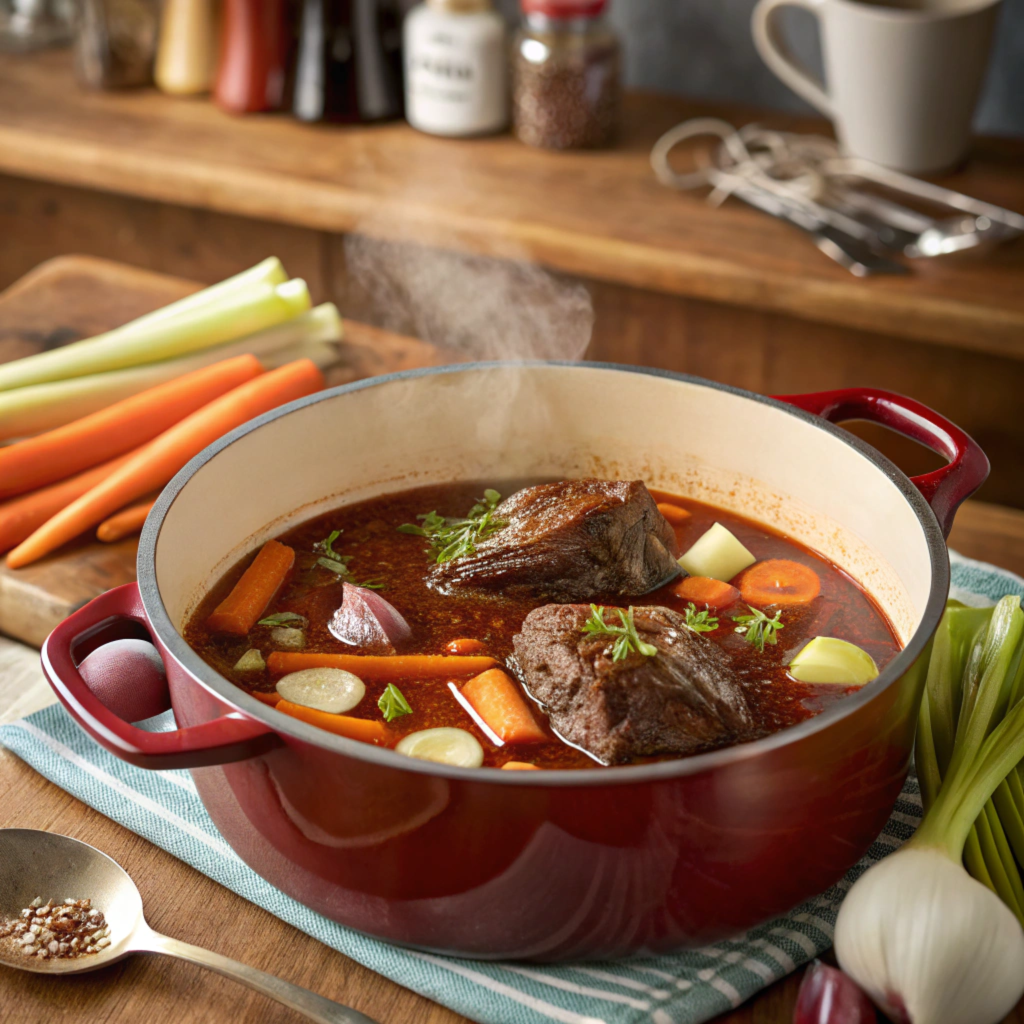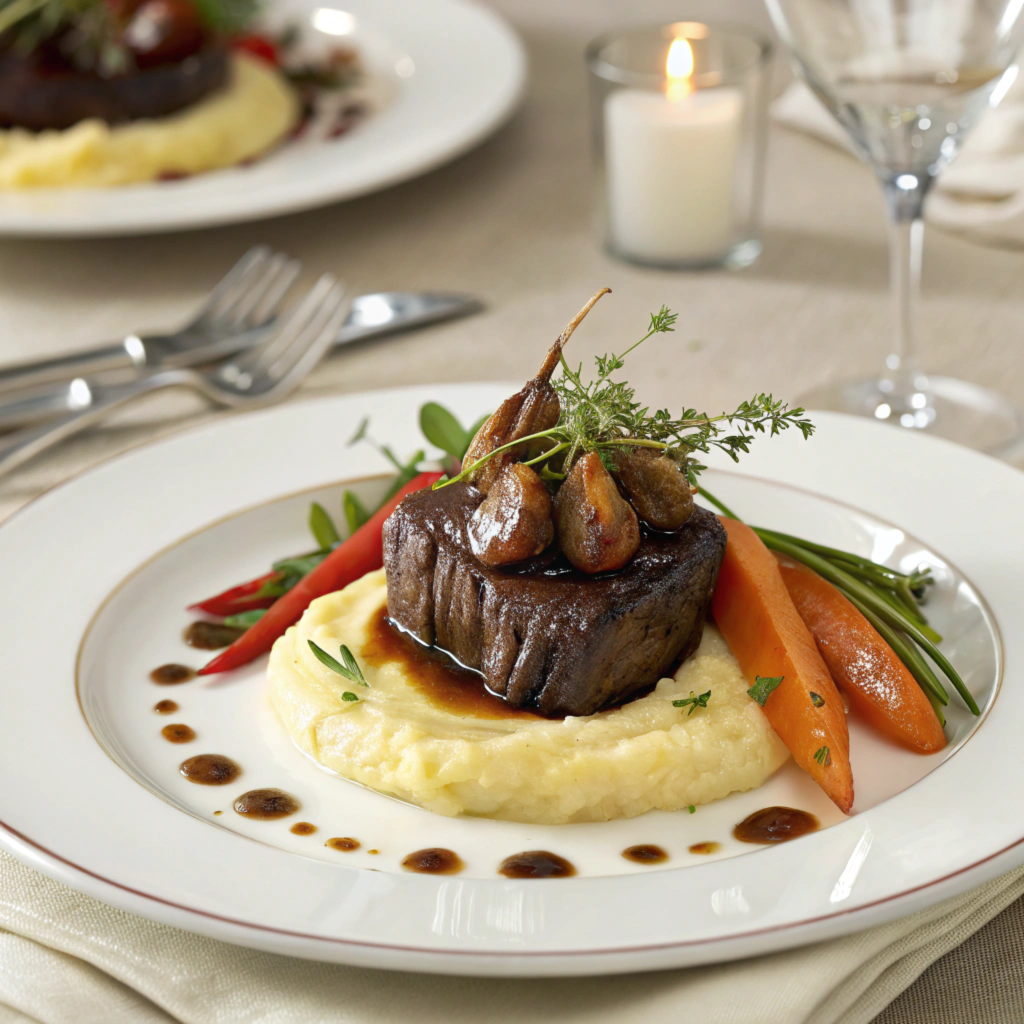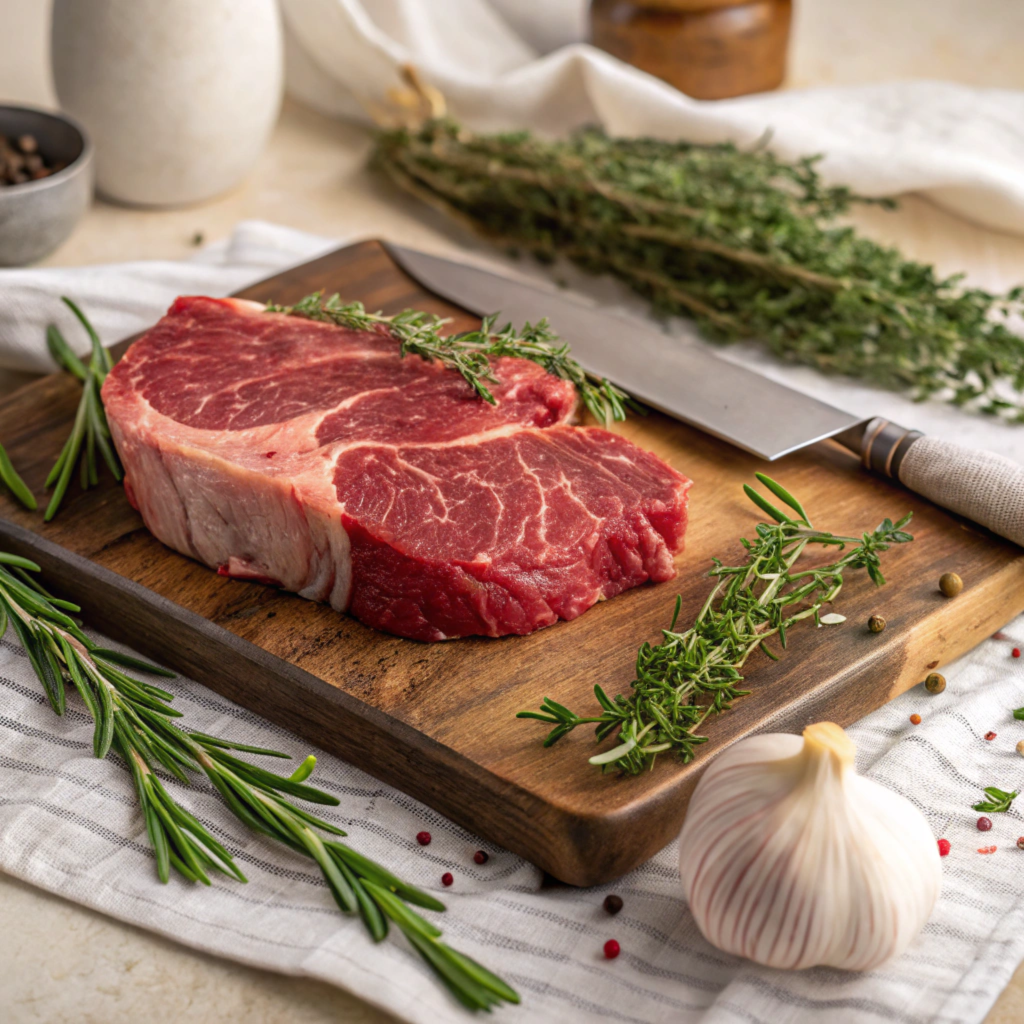Beef cheeks are a culinary treasure often overlooked by many. With their rich flavor, tender texture, and versatility, they have become a favorite among chefs and home cooks alike. This guide will explore everything from what Facial meat cuts are to how to cook them perfectly.

What Are Beef Cheeks?
Beef cheeks are the facial muscles of cattle, known for their dense structure and high amount of connective tissue. This unique characteristic makes them ideal for slow cooking, allowing the collagen to break down and create an irresistibly tender and flavorful dish.
Key Characteristics of Beef Cheeks:
- Flavor: Deep, beefy, and robust.
- Texture: When cooked properly, they become melt-in-your-mouth tender.
- Cost: Economical compared to other cuts of meat.
- Versatility: Can be used in a variety of cuisines and dishes.
If you’ve never cooked with beef cheeks before, you’re in for a delightful experience. They are a staple in dishes like braises, stews, and even tacos.
Why Are Beef Cheeks So Popular?
In recent years, Cheek meat have gained immense popularity among food enthusiasts. This is largely due to their affordable price and the incredible results they yield when cooked properly. Their high collagen content makes them ideal for low and slow cooking methods like braising, which transforms them into tender, flavorful perfection.
Reasons Behind Their Popularity:
- Health Benefits: Rich in protein, iron, and essential nutrients.
- Sustainability: Utilizes a less common part of the animal, reducing food waste.
- Culinary Trend: Featured in upscale restaurants, particularly in dishes like braised beef cheeks or osso buco substitutes.
Learn more about beef’s sustainability here.
How to Select the Best Beef Cheeks
Choosing quality beef cheeks is the first step to creating a memorable dish. Here’s what to look for:
- Freshness: Opt for bright red beef cheeks with minimal discoloration.
- Marbling: Look for a good amount of fat and connective tissue, which contributes to the flavor and texture during cooking.
- Size: Uniformly sized cuts ensure even cooking.
When shopping, ask your butcher for help if needed. They can provide tips on trimming and preparation, ensuring you get the most out of this fantastic cut.
Cooking Cheek meat: Techniques and Tips
The Secret to Perfect Beef Cheeks
The secret lies in slow cooking. This method allows the connective tissues and collagen to break down, resulting in that luscious, fork-tender texture.
Popular Cooking Methods:
- Braising: The most common method. Cook the beef cheeks in a flavorful liquid over low heat for several hours.
- Slow Cooker: Ideal for hands-off cooking. Combine your ingredients, set the timer, and let the magic happen.
- Pressure Cooking: Perfect for reducing cooking time while still achieving tenderness.
- Smoking: Adds a unique, smoky flavor to the rich Cheek meat.
Recipe Ideas for Beef Cheeks
Ready to try your hand at cooking beef cheeks? Here are a few ideas to inspire you:
Braised Facial meat cuts
- Ingredients: Beef jowls, beef stock, onions, garlic, carrots, celery, herbs.
- Method: Sear the beef cheeks, sauté vegetables, add liquid, and simmer for 4-6 hours.
Beef Cheek Tacos
- Ingredients: Shredded Cheek meat, tortillas, avocado, salsa, lime, cilantro.
- Method: Slow-cook beef cheeks with spices, shred, and serve in warm tortillas.
Beef Cheek Ragu
- Ingredients: Beef cheeks, tomatoes, garlic, onions, red wine, pasta.
- Method: Braise beef cheeks in a tomato-based sauce and serve over pasta.
For more recipe inspiration, check out this collection of beef cheek dishes.
The Nutritional Value of Beef Cheeks
Beef cheeks aren’t just delicious—they’re also packed with nutrients. Here’s why they deserve a spot on your plate:
- Protein: Essential for muscle growth and repair.
- Iron: Vital for oxygen transport in the blood.
- Collagen: Promotes skin health and joint support.
- Low in Calories: A lean cut of meat when trimmed of excess fat.
Tips for Storing and Freezing Beef Cheeks
Proper storage ensures that your beef cheeks remain fresh and safe to eat.
Storing in the Refrigerator:
- Keep them in an airtight container or vacuum-sealed bag.
- Use within 2-3 days for the best quality.
Freezing Beef jowls:
- Wrap tightly in plastic wrap or foil, then place in a freezer-safe bag.
- Label with the date and use within 3 months.
- Thaw in the refrigerator overnight before cooking.
Frequently Asked Questions (FAQs)
- What do beef cheeks taste like?
- They have a rich, beefy flavor with a silky texture when slow-cooked.
- How long does it take to cook beef cheeks?
- Typically 3-4 hours for braising, or 8-10 hours in a slow cooker.
- Can I cook beef cheeks in a pressure cooker?
- Yes, they take about 45-60 minutes in a pressure cooker.
- Are beef cheeks healthy?
- Yes, they are high in protein, iron, and collagen.
- What cuisines use beef cheeks?
- Popular in Italian, French, Mexican, and Asian cuisines.
- How do I trim Beef jowls?
- Remove excess fat and sinew with a sharp knife before cooking.
- Do beef cheeks shrink during cooking?
- Yes, they reduce in size due to the breakdown of collagen.
- What is the best wine to use for braising beef cheeks?
- A dry red wine like Cabernet Sauvignon or Merlot works best.
- Can I substitute Beef jowls with another cut?
- Short ribs or oxtail are good substitutes.
- Where can I buy beef cheeks?
- Look for them at local butcher shops or specialty meat markets.

Part 2: The Art and Science of Cooking Beef jowls
Cooking beef cheeks isn’t just a culinary task—it’s an art form that requires patience and technique. This part will delve into more advanced tips, pairing ideas, and cultural significance. By the end, you’ll be equipped to elevate your beef cheek dishes to restaurant-quality levels.
Advanced Tips for Cooking Beef Cheeks
Cooking beef cheeks perfectly is all about the details. Here are some advanced tips to help you master this cut:
1. Marinate for Maximum Flavor
- Why it works: Marinating infuses the meat with additional flavors while tenderizing it.
- Recommended marinades: A blend of red wine, garlic, rosemary, and olive oil works wonders.
- How to do it: Let the beef cheeks sit in the marinade for 8-12 hours in the refrigerator.
2. Searing: Don’t Skip This Step
- Purpose: Searing locks in juices and creates a caramelized crust that enhances the flavor.
- Technique: Heat a heavy pan until smoking hot, then sear each side for 2-3 minutes.
- Pro Tip: Use a neutral oil with a high smoke point, like grapeseed or canola oil.
3. Layer Flavors in Your Cooking Liquid
- Use a combination of aromatics like onions, garlic, and celery.
- Add acidity with tomatoes, vinegar, or wine.
- Enhance depth with beef stock, soy sauce, or Worcestershire sauce.
4. Cook Low and Slow
- Why it’s critical: This allows the collagen to break down, turning tough muscle into tender meat.
- Ideal temperature: 300°F (150°C) in the oven or the low setting on a slow cooker.
5. Rest Before Serving
- Let the cooked beef cheeks rest for 10-15 minutes before slicing or serving.
- Resting redistributes the juices, ensuring a moist and flavorful bite.
Discover more about the science of braising meat.
Pairing Cheek meat with Sides and Drinks
A well-prepared beef cheek dish deserves the perfect accompaniments.
Ideal Side Dishes
- Creamy Mashed Potatoes: Their richness balances the beef’s intensity.
- Polenta: Soft polenta provides a velvety texture that complements the tender cheeks.
- Roasted Root Vegetables: Carrots, parsnips, and turnips bring sweetness and a rustic touch.
- Risotto: A hearty mushroom or saffron risotto pairs beautifully.
Drink Pairings
- Red Wine: Full-bodied options like Malbec, Syrah, or Chianti.
- Craft Beer: A stout or porter enhances the beef’s depth.
- Non-Alcoholic: A robust herbal tea or sparkling grape juice.
Beef Cheeks in Global Cuisines
The humble beef cheek has found its way into kitchens around the world. Here’s how different cultures celebrate this cut:
1. Italian Cuisine
- Dish: Brasato al Barolo (Cheek meat braised in Barolo wine).
- Flavors: Earthy, rich, and aromatic.
2. French Cuisine
- Dish: Daube de Boeuf (Provencal beef stew).
- Flavors: Olive oil, garlic, and herbs like thyme and bay leaves.
3. Mexican Cuisine
- Dish: Barbacoa (slow-cooked shredded beef cheeks).
- Flavors: Smoky, spicy, and tangy, served with fresh tortillas.
4. Asian Cuisine
- Dish: Soy-Braised Beef Cheeks.
- Flavors: A blend of soy sauce, ginger, garlic, and star anise.
Explore more about global beef dishes here.
How to Achieve the Perfect Texture
The texture of beef cheeks is a true hallmark of their quality. Achieving that signature melt-in-your-mouth feel requires precision:
- Monitor Cooking Time
- Overcooking can turn tender meat into mush.
- Check for doneness by gently pressing with a fork; it should slide through effortlessly.
- Use the Right Cooking Liquid
- Liquids rich in collagen, like bone broth, enhance the final texture.
- Avoid too much water—it dilutes the flavor.
- Test Midway
- Taste periodically to ensure the meat is absorbing the seasoning.
Cheek meat: A Budget-Friendly Gourmet Option
One of the best-kept secrets in the culinary world is how affordable beef cheeks are compared to other cuts like short ribs or brisket.
Why They’re Cost-Effective
- Derived from a lesser-used muscle.
- Often sold in bulk at local butcher shops or meat markets.
Pro Tip for Buying the dense muscle of a cow’s cheek
- Ask for deals: Many butchers are happy to provide discounts on larger purchases.
- Buy fresh, not frozen: This ensures better texture and flavor.
Sustainability and Beef Cheeks
By choosing Cheek meat, you’re making an environmentally conscious choice. This cut is part of the movement to utilize the entire animal, reducing waste and promoting sustainability.
How to Source Ethically:
- Purchase from local, grass-fed farms.
- Look for certifications like USDA Organic or Animal Welfare Approved.
- Support butchers who prioritize humane practices.
For insights into sustainable beef farming, visit Sustainable Table.
Storage Tips for Cooked Beef Cheeks
If you’ve got leftovers (lucky you!), here’s how to store them properly:
Refrigeration
- Cool completely before storing.
- Place in an airtight container.
- Consume within 3 days for optimal flavor.
Freezing
- Portion into smaller servings for convenience.
- Store in freezer-safe bags with some cooking liquid to retain moisture.
- Freeze for up to 3 months.
To reheat, gently warm on the stovetop with additional broth or sauce.
Elevating Beef Cheeks: Chef-Inspired Ideas
If you want to go beyond the basics, try these elevated approaches to beef cheeks:
- Beef Cheek Ravioli
- Shred the braised cheeks and mix with ricotta cheese.
- Stuff into fresh pasta and serve with a sage butter sauce.
- Smoked Beef Cheek BBQ
- Smoke cheeks with hickory wood, then glaze with a tangy BBQ sauce.
- Beef Cheek Pie
- Combine shredded beef cheeks with vegetables and gravy, then bake in a flaky pastry shell.
For creative spins on classic dishes, check out this recipe collection.
FAQs About Beef Cheeks
- Can I overcook beef cheeks?
- Yes, overcooking can make them overly soft and unappealing.
- What’s the best way to trim beef cheeks?
- Remove excess sinew and fat with a sharp knife.
- Are beef cheeks suitable for grilling?
- They’re better suited for slow cooking methods due to their toughness.
- Can I substitute chicken stock for beef stock?
- Yes, but beef stock provides a deeper flavor.
- Do I need to season beef cheeks heavily?
- They benefit from bold flavors, but don’t overdo the salt.
- How do I reheat frozen beef cheeks?
- Thaw overnight and reheat gently in a sauce or broth.
- Can I cook beef cheeks in the oven?
- Absolutely! Use a Dutch oven for best results.
- What’s the shelf life of frozen beef cheeks?
- Up to 3 months if properly stored.
- Do beef cheeks taste gamey?
- No, they have a rich, clean beef flavor.
- What herbs pair well with beef cheeks?
- Rosemary, thyme, and bay leaves are excellent choices.

Part 3: Mastering the dense muscle of a cow’s cheek – Expert Advice and Advanced Techniques
By now, you’ve explored the basics and advanced methods of cooking beef cheeks. In this final segment, we’ll dive into expert techniques, discuss how to host the ultimate dinner featuring beef cheeks, and answer the most pressing questions you might still have.
Expert Techniques for the Perfect Beef Cheeks
If you’re ready to elevate your beef cheek dishes to a professional level, these advanced techniques will help:
1. Sous Vide for Precision Cooking
- Why it works: Sous vide allows for precise temperature control, ensuring perfectly tender beef cheeks every time.
- How to do it:
- Season the cheeks and seal them in a vacuum bag with aromatics.
- Cook in a water bath at 185°F (85°C) for 12-18 hours.
- Sear before serving to add a caramelized crust.
2. Infusing Smoke
- Use a smoker or a smoking gun to add a layer of complexity to the beef cheeks.
- Pair with wood chips like hickory or mesquite for bold flavors.
3. Finishing with a Glaze
- Reduce the braising liquid to a syrupy consistency and glaze the beef cheeks during the last 10 minutes of cooking.
- Popular glazes include balsamic reduction or a honey-soy mixture.
4. Experimenting with Spices
- Go beyond traditional flavors and explore spices like cinnamon, cardamom, and cloves for a Moroccan-inspired twist.
Learn more about sous vide techniques.
Hosting the Ultimate Beef Cheek Dinner
A dinner centered around beef cheeks is guaranteed to impress your guests. Here’s how to plan the perfect evening:
1. Set the Menu
- Starter: Begin with a light soup or salad, such as roasted beet salad with goat cheese.
- Main: Serve braised beef cheeks with creamy polenta and roasted vegetables.
- Dessert: Opt for something decadent yet light, like a lemon tart or panna cotta.
2. Presentation Tips
- Serve the beef cheeks on a platter with a drizzle of the reduced braising liquid.
- Garnish with fresh herbs like parsley or thyme for a pop of color.
3. Drink Pairings
- A robust red wine, such as a Zinfandel or a Bordeaux, will complement the dish perfectly.
- Offer a sparkling water with lemon as a non-alcoholic option.
Innovative Ways to Use Leftover BEEF CHEEKS
Leftovers don’t have to be boring. Here are some creative ways to repurpose the dense muscle of a cow’s cheek
- Beef Cheek Sliders
- Shred the beef cheeks and serve on mini buns with pickles and slaw.
- Cheek and Cheese Pizza
- Use shredded beef cheeks as a pizza topping along with caramelized onions and mozzarella.
- Beef Cheek Pot Pie
- Combine leftovers with vegetables and gravy, then bake with a flaky crust.
- Asian-Inspired Noodle Bowls
- Add shredded beef cheeks to ramen or udon noodles with a savory broth.
- Beef Cheek Quesadillas
- Layer shredded beef with cheese and jalapeños in a tortilla.
Explore more leftover recipe ideas.
The Legacy of Beef Cheeks in Culinary History
Beef cheeks have been cherished in cuisines for centuries. Here’s a brief look at their historical significance:
- Ancient Rome: Slow-cooked meats, including cheek cuts, were a staple in Roman feasts.
- Medieval Europe: the dense muscle of a cow’s cheek were common in stews for peasants, as they were inexpensive yet filling.
- Modern Times: Thanks to their versatility and depth of flavor, beef cheeks are now featured in Michelin-starred menus worldwide.
This historical context adds to their appeal as a timeless ingredient.
Final FAQs About Beef Cheeks
Here are 10 additional FAQs to ensure you’ve got every detail covered:
- What is the best way to reheat beef cheeks without drying them out?
- Reheat in a covered dish with some reserved braising liquid at low heat.
- Can I use beef cheeks in a curry?
- Absolutely! Their richness works well with Indian or Thai curry spices.
- How do I know if my beef cheeks are cooked perfectly?
- Insert a fork; the meat should shred easily without resistance.
- What is the average weight of a beef cheek?
- Typically, each cheek weighs about 12-16 ounces.
- Is it necessary to use wine for braising beef cheeks?
- No, you can use beef stock or tomato-based liquids as alternatives.
- How long can cooked Cheek meat stay in the fridge?
- Up to 3 days in an airtight container.
- Can the dense muscle of a cow’s cheek be cooked from frozen?
- It’s better to thaw them first for even cooking.
- What kind of knife is best for trimming beef cheeks?
- A sharp boning or utility knife works best.
- Do gourmet Cheek meat need to be flipped during cooking?
- No, as long as they are fully submerged in the cooking liquid.
- Can I pair beef cheeks with seafood?
- Yes, a surf-and-turf dish featuring scallops or shrimp can work beautifully.
Conclusion
Beef cheeks are a culinary gem that can transform a humble meal into a gourmet experience. Whether you’re slow-cooking them in a braise, experimenting with sous vide, or adding them to innovative dishes, their depth of flavor and melt-in-your-mouth texture make them a standout choice.
With the right techniques, thoughtful pairings, and a touch of creativity, beef cheeks can become the centerpiece of unforgettable meals. From their historical roots to their modern-day resurgence, they truly deserve a spot on your table.
Now that you’ve mastered everything about gourmet Cheek meat, it’s time to get cooking and savor the results!
